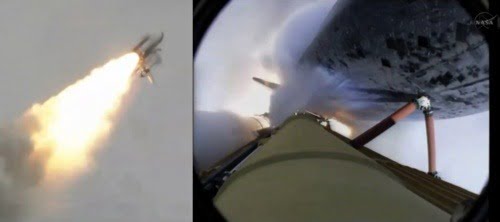Condensation clouds form around sections of Atlantis as STS-135–the final space shuttle flight–launches from Cape Canaveral this morning. These clouds, also called Prandtl-Glauert singularities or vapor cones, form at transonic speeds when air accelerates around the vehicle. The area just behind these shock waves experiences a drop in pressure and temperature that brings a localized portion of the flow below the dew point. Rapid condensation of the moisture in the air results. Miss the launch? Watch it here.
Search results for: “shock wave”

Rocket Diamonds
The exhaust of a Pratt and Whitney J58 shines with Mach diamonds, a series of shock waves and expansion fans that form to equalize the exhaust and ambient pressures. This pattern can occur any time an engine nozzle operates at its non-ideal altitude.

X-51A Scramjet Test Flight
The X-51A Waverider hypersonic aircraft had its second test flight earlier this week. Unfortunately, its supersonic combustion ramjet (scramjet) engine failed to transition from its start-up fuel to its primary fuel. According to the US Air Force Research Laboratory:
A US Air Force B-52H Stratofortress released the experimental vehicle from an altitude of approximately 50,000 feet. After release the X-51A was initially accelerated by a solid rocket booster to a speed just over Mach 5. The experimental aircraft’s air breathing scramjet engine lit on ethylene and attempted to transition to JP7 fuel operation when the vehicle experienced an inlet un-start. The hypersonic vehicle attempted to restart and oriented itself to optimize engine start conditions, but was unsuccessful. The vehicle continued in a controlled flight orientation until it flew into the ocean within the test range. #
Un-starting is the term used when supersonic flow is lost in an engine or wind tunnel. If the pressure or temperature in the engine deviates too far from the ideal conditions, the upstream mass flow through the engine will be greater than the downstream mass flow and the engine will choke (video). A shock wave forms and travels upstream, leaving subsonic flow in its wake. Loss of supersonic flow inside the engine would likely also result in losing ignition of the fuel/air mixture, resulting in flameout. #
If you haven’t guessed already, engineers like to make up words.

Space Shuttle Flow Viz
When a space shuttle lands, a lucky few will hear twin sonic booms as it passes overhead. The double boom occurs due to the shock waves from in front of the shuttle and just behind it passing the observer on the ground. The colorized schlieren photograph above shows shock waves on a model of an early shuttle prototype. The fore and aft shocks that run from the craft to the ground are even clearer on this photo of a T-38 in flight. (Photo credit: Gary Settles)
Supersonic Bullet
[original media no longer available]
This video shows a CFD simulation of a bullet passing through a parallel channel at Mach 2. The simulation captures 3 milliseconds of real-time and shows the Mach number in the top view and the temperature in the bottom view. Note how the bow shock near the front of the bullet and the trailing shock behind it reflect off the walls of the channel and interact. Even though the calculation is inviscid, the shock waves cause intense heating (white) in front of and behind the bullet.

Rocket Launch Phenomena
The launch of the Solar Dynamics Observatory (SDO) last year provided a rarely seen glimpse of how shock waves affect the atmosphere during launch, but only recently have researchers explained the white column that seemed to follow SDO toward orbit. Simulations indicate that the shock waves from the rocket aligned the ice crystals in the atmosphere into an array of spinning tops. Individual crystals precess as a result of the rocket passing; the column is part of a larger oval that would have been visible had the ice crystals covered a larger range. See Wired for more. #

Mach Diamonds
Joe asks:
Why does this rocket have that repeating pattern in its exhaust? I’m amazed that it’s so stable for so far as distance from the nozzle.
Excellent question! The diamond-shaped pattern seen in the rocket’s exhaust is actually a series of reflected shock waves and expansion fans. The rocket’s nozzle is designed to be efficient at high altitudes, which means that, at its nominal design altitude, the shape of the nozzle is such that the exhaust gases will be expanded to the same pressure as the ambient atmosphere. At sea level, the nozzle is overexpanded, meaning that the exhaust gases have been expanded to a lower pressure than the ambient. The supersonic exhaust has to reach ambient pressure, and it does so through an oblique shock right at the exit of the nozzle. However, the oblique shock, in addition to raising the pressure, turns the gases toward the exhaust centerline. To ensure flow symmetry, two additional oblique shocks form. But then the exhaust is at a higher pressure than ambient. Expansion fans form to reduce the pressure, but those, too, affect the direction the exhaust gases flow. The pattern, then, is a series of progressively weaker oblique shocks and expansion fans that raise the exhaust gas pressure to that of the ambient atmosphere.

Seeing the Invisible
Schlieren photography is a common experimental flow visualization technique, especially in supersonic flows (where it enables one to see shock waves). Here the Science Channel’s “Cool Stuff: How It Works” show explains the technique and shows some examples from everyday life.

Supersonic
Moving supersonically–faster than the local speed of sound–can cause some awesome effects. Among these are vapor cones (a.k.a. Prandlt-Glauert singularities), shock waves, and, of course, the sonic boom.

